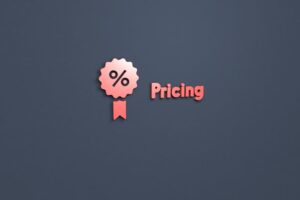Everyday Low Pricing Definition
Everyday Low Pricing (EDLP) is a pricing strategy where businesses consistently maintain low product prices, avoiding frequent sales or discounts.
The goal is to create consumer trust by avoiding the frequent changes and fluctuations found in other pricing strategies.
With everyday low pricing, consumers will be less inclined to wait for sales or promotions and are more likely to make consistent purchases.
EDLP for Software Solutions
For the software industry, EDLP entails offering services at a consistent, competitive price point. The goal isn’t to give discounts at random but to give long-term value.
Companies like Adobe have switched to subscription models, giving customers constant access to a set of products for a fixed price.
This strategy fits with the EDLP principles and lets users see value without waiting for discounts.
Everyday pricing strategy helps build long-term relationships by removing the uncertainty of price changes.
MORE: What is bundle pricing?

Advantages of Everyday Low Pricing
Predictability for Customers
Customers are less likely to feel pressured into making a purchase since EDLP pricing is consistent and there are no limited-time offers, which boosts customer satisfaction and loyalty.
Simplified Marketing and Promotions
A streamlined marketing strategy based on consistent pricing reduces campaign costs and allows businesses to establish a reputation for value and reliability.
Reduced Administrative and Operational Costs
Businesses can keep their prices low and profit margins high with the reduced paperwork involved in running promotions.
Building Trust with Customers
A constant, low-price strategy helps build a transparent and trusted relationship with customers by assuring them of receiving value without losing out on deals.
MORE: What is decoy pricing?
Disadvantages of Everyday Low Pricing
Difficulty in Attracting Deal-Seeking Customers
Switching to an EDLP model may be met with initial opposition from consumers accustomed to looking for discounts and may regard everyday low pricing as lacking in value.
Requires Efficient Operations to Maintain Profitability
The success of EDLP is dependent on a company’s ability to maintain operational efficiency and cost-effectiveness in its supply chain to protect margins.
Less Flexibility in Adjusting to Market Fluctuations
A rigid pricing structure can expose businesses to market volatility, necessitating a solid risk management strategy to mitigate any adverse impacts.
MORE: What is penetration pricing?
EDLP vs. High-Low Pricing
| EDLP | High-Low Pricing |
|---|---|
| Promises consumers a stable, consistent, and low price. | It is all about the highs and lows. |
| No limited-time offers. | Gives customers thrilling high sales. |
| Regular prices may feel steep. |
Both strategies require careful consideration of the company’s brand image, intended audience, and operational capabilities due to the different market segments they serve.
EDLP Examples
Walmart
Walmart is arguably the most well-known proponent of EDLP, and its motto, “Always Low Prices,” sums up its dedication to this pricing strategy. They have gained customers’ trust and kept their status as a top worldwide retailer by providing consistently low prices.
Amazon Web Services (AWS)
AWS has gently implemented an EDLP-inspired approach, frequently cutting pricing as they scale, delivering consistent value to their enormous clientele.
This approach has cemented AWS’s market leadership and played a critical role in attracting a varied customer base ranging from startups to large corporations.
Basecamp
Basecamp is a project communication software with a straightforward flat-cost pricing model. There is a fixed, predictable monthly or annual fee.
This pricing simplicity has attracted small enterprises and huge teams that prefer simple budgeting without fluctuating prices or the risk of missing out on offers.
Is EDLP Good for My Business?
Everyday Low Pricing (EDLP) depends on your business’s dynamics and objectives.
For instance, Amazon Web Services (AWS) uses an EDLP-inspired technique to cut rates as they scale, increasing user engagement and dominance.
While EDLP can simplify the pricing model and create trust with a consistent pricing message, it may limit promotional campaigns and special offers, which are typically essential for acquiring new users or re-engaging lapsed ones.
High-low pricing may be better for your business if your business thrives on regular feature releases and speedy customer acquisition campaigns.
However, EDLP might be useful if you want sustainable development, long-term trust, and operational efficiency to support low prices.
MORE: What is enterprise pricing?
Key Considerations for Implementing EDLP in Your Business
1. Cost Structure
For EDLP to be effective, your company’s cost structure must be low and efficient. Consistently low prices while maintaining profitability requires optimizing operational expenses and supply chains.
2. Consumer Preference
Understanding your target audience’s requirements and preferences is essential. Some customers like consistent, predictable prices, while others are drawn to promotional offers and discounts.
For EDLP to be effective, you must understand how your customers behave and adjust your pricing structures accordingly.
3. Product Lifecycle
EDLP’s suitability depends on a product’s lifecycle. Promotional pricing may work better for newer products to gain market share, while EDLP may work better for older products with steady demand.
4. Customer Loyalty
EDLP can increase customer loyalty by eliminating the need for customers to wait for discounts or compare pricing.
5. Operational Simplicity
Simple EDLP removes the logistical and administrative challenges of frequent price changes and promotions. As a result of this ease of administration, businesses can focus on improving their products and services rather than managing price fluctuations.
MORE: What is geographical pricing?
EDLP’s Relevance to SaaS
While EDLP is deeply rooted in the retail sector, its principles also apply to Software providers. Here’s why:
- Consistent Pricing Builds Trust: Just as retail customers value price predictability, SaaS clients prefer knowing they’re getting consistent value without worrying about price increases or promotional periods.
- Simplified Marketing Efforts: Because prices and promotions aren’t constantly changing, SaaS companies can focus on marketing their products’ features, benefits, and value propositions, resulting in clearer brand messaging.
- Customer Retention: An EDLP strategy can reduce churn rates. Customers are less likely to shop for alternatives if they know they’re getting a good deal.
- Cost predictability: For subscription-based SaaS companies, consistent pricing means more predictable revenue streams and financial forecasting.
MORE: What is market-based pricing?
Key Takeaways
Everyday Low Pricing is more than just setting low prices; it’s also about giving customers value, predictability, and honesty.
While it might not appeal to people who thrive on changing promotions, it can build trust with a sizable segment of shoppers.
In today’s market, it’s essential to understand EDLP, whether you’re a retailer thinking about using this strategy or a customer trying to figure out what to buy.
For more pricing information to help guide your business, visit our SaaS Pricing pages.
Related Posts
Frequently Asked Questions (FAQ)
Author
Methodology
- Who?
We are SaaS experts: Our specialists constantly seek the most relevant information to help support your SaaS business. - Why?
We are passionate about users accessing fair SaaS pricing: We offer up-to-date pricing data, reviews, new tools, blogs and research to help you make informed SaaS pricing decisions. - How?
With accurate information: Our website manager tests each software to add a Genius Score using our rating methodology to each product. Our editorial team fact-check every piece of content we publish, and we use first-hand testing, value metrics and leading market data.










